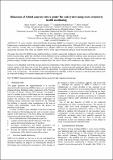| dc.contributor.author | Newell, S. | |
| dc.contributor.author | Goggins, Jamie | |
| dc.contributor.author | Hajdukiewicz, Magdalena | |
| dc.contributor.author | Holleran, D. | |
| dc.date.accessioned | 2016-12-13T15:31:27Z | |
| dc.date.available | 2016-12-13T15:31:27Z | |
| dc.date.issued | 2016-08-29 | |
| dc.identifier.citation | Newell, S, Goggins, J, Hajdukiewicz, M, Holleran, D (2016) Behaviour of hybrid concrete lattice girder flat slab system using insitu structural health monitoring Civil Engineering Research in Ireland Conference (CERI 2016) Galway, Ireland, 29/08/2016- 30/08/2016 | en_IE |
| dc.identifier.uri | http://hdl.handle.net/10379/6232 | |
| dc.description.abstract | In recent decades, Structural Health Monitoring (SHM) has emerged as an increasingly important tool in Civil Engineering to understand how structures behave during construction and operation. Although SHM is not a new concept, it is only relatively recently that Civil Engineers have adopted SHM for the design, construction and management of civil engineering structures. One of the key benefits of SHM is the improved understanding of insitu structural behaviour. This paper describes the SHM strategy implemented on a recently constructed building to monitor and record the behaviour of a hybrid concrete lattice girder flat slab floor system. Hybrid concrete construction (HCC) combines insitu and precast concrete to maximise the benefits of both forms of construction. HCC offers many advantages for both the designer and contractor and produces simple, buildable and economic structures which can result in faster, safer construction and reduced costs. Sensors were embedded in both the precast and insitu components of the hybrid concrete floor system and are used to monitor various aspects of the behaviour of the floor during the manufacture, construction and operational phase of the building. The information from the real-time monitoring offers the opportunity to compare actual and predicted behaviour using structural codes, such as Eurocodes. The majority of the instrumentation is embedded within the structure so that long-term effects such as creep and shrinkage of concrete components can also be investigated. | en_IE |
| dc.description.sponsorship | The authors would like to acknowledge the support of the
European Commission Horizon 2020 project Built2Spec
(637221). The support of Oran Pre-Cast Ltd. is
gratefully acknowledged with respect to installation of sensors
in the precast concrete elements. The second author would
also like to acknowledge the support of Science Foundation
Ireland through the Career Development Award programme
(Grant No. 13/CDA/2200) and the National Centre for Marine
and Renewable Energy Ireland (MaREI) (Grant no.
12/RC/2302). | en_IE |
| dc.format | application/pdf | en_IE |
| dc.language.iso | en | en_IE |
| dc.publisher | NUI Galway | en_IE |
| dc.relation.ispartof | Civil Engineering Research in Ireland Conference (CERI 2016) | en |
| dc.rights | Attribution-NonCommercial-NoDerivs 3.0 Ireland | |
| dc.rights.uri | https://creativecommons.org/licenses/by-nc-nd/3.0/ie/ | |
| dc.subject | Structural health monitoring | en_IE |
| dc.subject | Lattice girder flat slab | en_IE |
| dc.subject | Structural monitoring | en_IE |
| dc.subject | Civil engineering | en_IE |
| dc.title | Behaviour of hybrid concrete lattice girder flat slab system using insitu structural health monitoring | en_IE |
| dc.type | Conference Paper | en_IE |
| dc.date.updated | 2016-12-09T12:37:18Z | |
| dc.identifier.doi | 10.13025/S8MS34 | |
| dc.local.publishedsource | http://doi.org/10.13025/S8MS34 | |
| dc.description.peer-reviewed | non-peer-reviewed | |
| dc.contributor.funder | |~|1267872|~|1267883|~| | |
| dc.internal.rssid | 11708947 | |
| dc.local.contact | Magdalena Hajdukiewicz, Civil Engineering Eng 1023, Engineering Building, College Of Eng & Informatics, Nui Galway. Email: magdalena.hajdukiewicz@nuigalway.ie | |
| dc.local.copyrightchecked | Yes | |
| dc.local.version | PUBLISHED | |
| nui.item.downloads | 659 | |


